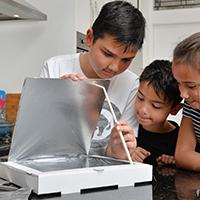Solar Cookie Oven

How to create your very own Cookie Oven
Equipment & Ingredients
- Clear tape / sticky tape or glue Black paper
- A warm, sunny day!
- Pencil
- Ruler
- Pizza box (a cereal box will work)
- Utility knife
- Aluminium foil
- Plastic wrap
- Cookie dough: 15g (1 Tbsp) butter, 30g (2 Tbsp) sugar, 25g (4 Tbsp) plain flour, 5ml (1 tsp) milk
Instructions

- Use a pencil and ruler to mark 2.5cm (1 inch) in from each side on the pizza box lid and draw a square to connect the marks.
- Cut along the front and side lines of the square with the utility knife. Fold along the back line so that it acts as a hinge.
- Line the inside of the flap and the inside walls of the box with foil, and tape or glue in place.
- Seal the cut-out window shape by taping a sheet of plastic wrap over the hole.
- Glue or tape a sheet of black paper to the bottom of the inside of the box.
- Mix the cookie dough ingredients and roll into small balls, then flatten with your hand.
- Arrange the discs of dough on a sheet of foil and place on top of the black paper inside the box.
- Prop the cut-out lid at a 75 degree angle (approx) using a pencil and some tape. Leave outside facing the sun until cookies are ready (anything from 15-60 minutes).
- Carefully remove the cookies from the box and allow to cool – then eat!

The Science Behind the Solar Oven
Solar ovens use heat emitted from the sun, called solar energy, to cook food.
The foil reflects sunlight into the box, and the plastic wrap acts like a greenhouse by preventing the heated air inside the box from escaping. As more heat from the sun streams into the box, the air inside gradually becomes warmer. The black paper in the bottom of the box absorbs the warm sunlight, which in turn heats the food placed on top of it.
Explore Further
» What other items can you cook in the solar oven? Could you bake a potato or even a pizza?
» Does changing the angle of the reflector flap change how efficient the solar oven is at cooking?
» Try using the oven on a warm but cloudy day. Does it still cook the cookies? Why do you think that is?
Dr Michelle Dickinson (MNZM) ‘prize winning nanotechnologist, researcher and educator’ has made it her life mission to make science and engineering accessible for all. Her new book The Kitchen Science Cookbook is packed full of fun ‘recipes’, each teaching an important scientific principle in a format that is perfect for parents and children to enjoy together.




